It seems tripod does not fancy links.
It works when copied to the address bar directly
http://lscon.tripod.com/xt1086/SPL.jpg
It works when copied to the address bar directly
http://lscon.tripod.com/xt1086/SPL.jpg
Hi dazydee,
Thanks for the tip.
I'm unable to get enough resolution to read the horizontal axis.
I'm guessing the numbers represent 1200 and 10000 Hz?
Maybe someone can help out, but does the HF resonance (about 16 kHz??) represent a resonance of the BMS driver??
That behaviour doesn't occur with my setup, nor in 18sound's published graphs.
David
Thanks for the tip.
I'm unable to get enough resolution to read the horizontal axis.
I'm guessing the numbers represent 1200 and 10000 Hz?
Maybe someone can help out, but does the HF resonance (about 16 kHz??) represent a resonance of the BMS driver??
That behaviour doesn't occur with my setup, nor in 18sound's published graphs.
David
around here now 2*de250+2*de500=1*nsd1095n..Around here the DE250 cost 2/3 of the NSD1095N
I was using the NSD1095N with the XT1086 horn, but then finally I decided to try it without any horn, to get rid of the 'horn sound' that comes with it and also I didn't want so much directivity that the horn offers.
So, I was surprised how good it sounds bare, even if it's not designed for it. The slight horn colorization is of course gone and the sound it is somehow more clear, detailed and brighter, even if I perfectly equalize the response to the listening spot to be the same with and without the horn.
The response without the horn drops rapidly below 3 khz but in my case it was not a problem since that happens to be the crossover point anyway. Also the response above it needed a lot of eq to straighten, but also that was not a problem when using a digital crossover.
So, I was surprised how good it sounds bare, even if it's not designed for it. The slight horn colorization is of course gone and the sound it is somehow more clear, detailed and brighter, even if I perfectly equalize the response to the listening spot to be the same with and without the horn.
The response without the horn drops rapidly below 3 khz but in my case it was not a problem since that happens to be the crossover point anyway. Also the response above it needed a lot of eq to straighten, but also that was not a problem when using a digital crossover.
18 Sound NSD1095N 1" 8ohm polar response measurement
Sorry for the really slow reply. I finally now had time to check it out. I don't have a program yet to produce the usual polar graphics, but I did measure the response with REW in my living room.
Starting straight ahead (90 degrees) at 3 meters and then keeping same distance, measuring every 10 degree steps all the way to the side to zero degrees.
The tweeter has the frequency response already corrected to the way I normally listen it, so that's why it's quite straight. Also it has 4th order high pass filter at 2900hz. I have found it to be a good choice when it's like this, bare naked without the XT1086 waveguide.
Under it is a wooden holder I quickly made for testing, it's ok as it does not produce reflections.
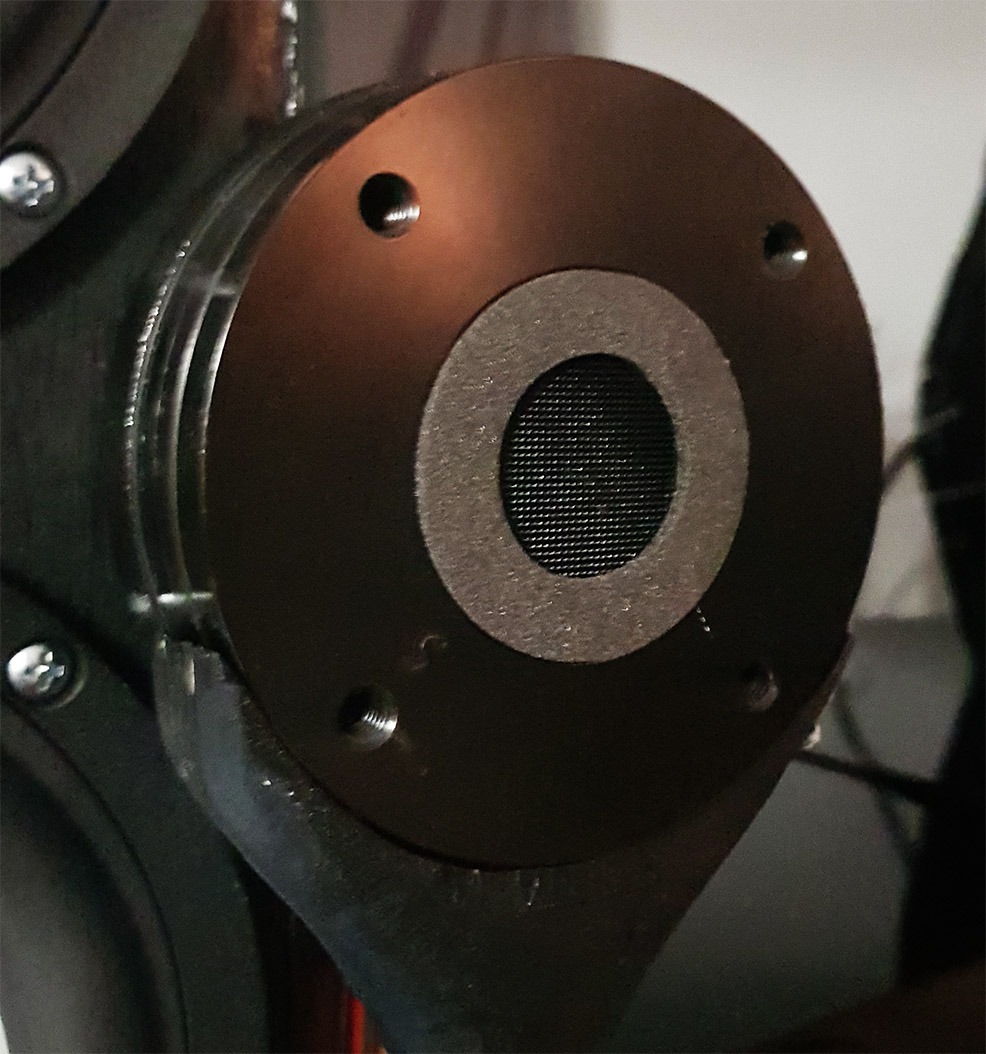
In this graph I included just three of the measurements, so it's not so cluttered.
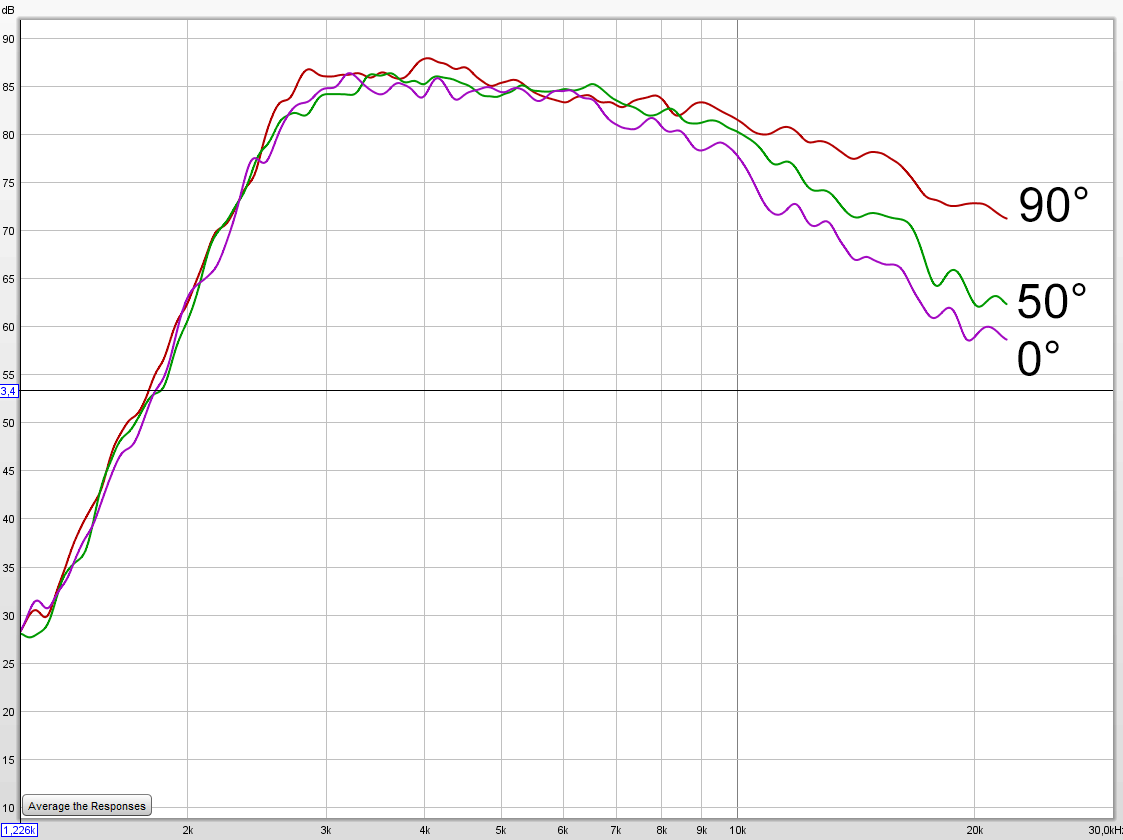
Here are all of them.
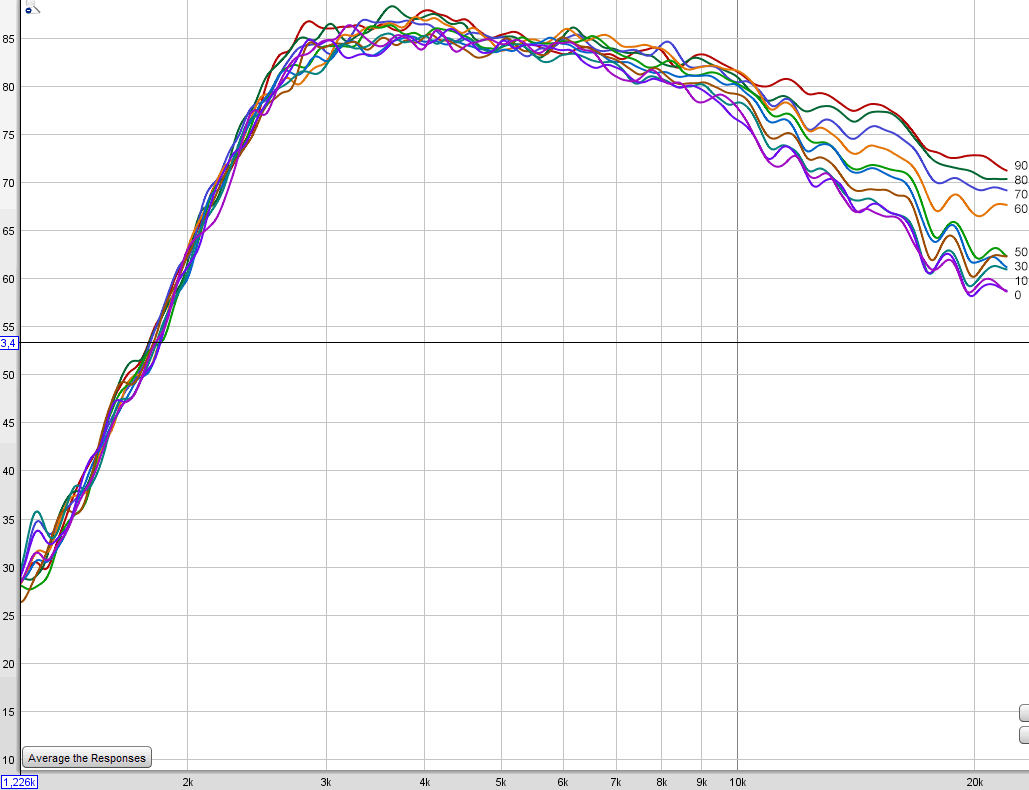
This verified what I have heard while listening, there are no major anomalies at any angle, and the field is quite wide which suits my purpose well, since I often have people listening and dancing all around the room.
Sorry for the really slow reply. I finally now had time to check it out. I don't have a program yet to produce the usual polar graphics, but I did measure the response with REW in my living room.
Starting straight ahead (90 degrees) at 3 meters and then keeping same distance, measuring every 10 degree steps all the way to the side to zero degrees.
The tweeter has the frequency response already corrected to the way I normally listen it, so that's why it's quite straight. Also it has 4th order high pass filter at 2900hz. I have found it to be a good choice when it's like this, bare naked without the XT1086 waveguide.
Under it is a wooden holder I quickly made for testing, it's ok as it does not produce reflections.

In this graph I included just three of the measurements, so it's not so cluttered.

Here are all of them.

This verified what I have heard while listening, there are no major anomalies at any angle, and the field is quite wide which suits my purpose well, since I often have people listening and dancing all around the room.
Last edited:
Machismo, Your measurements support why Troels Gravensen decided to add a super tweeter above the 18 Sound NSD1095N to his "The Loudspeaker rev1 & rev2".
======= as discussed on diyAudio ===
"At-Home" hearing tests are not very accurate, but they might be helpful for gross hearing issues and create data which triggers a visit to the doctor.
======= as discussed on diyAudio ===
"At-Home" hearing tests are not very accurate, but they might be helpful for gross hearing issues and create data which triggers a visit to the doctor.
What about them suggests this?measurements support why Troels Gravensen decided to add a super tweeter
He says he has it EQed the way he likes it. Maybe he just likes a strong downward slope toward the top.Machismo, Your measurements support why Troels Gravensen decided to add a super tweeter above the 18 Sound NSD1095N to his "The Loudspeaker rev1 & rev2".
======= as discussed on diyAudio ===
"At-Home" hearing tests are not very accurate, but they might be helpful for gross hearing issues and create data which triggers a visit to the doctor.
@ScottG
This is off topic concerning the main thread...
ScottG, I just love the way you present your perspective! There´s a reason why thoughts on "total objectivity" always end up in theological debates. What entity could claim "total objectivity"?
And rationally I think we end up with "critical rationalism" as explained by Karl Popper...
High regards to the highly qualified writers here! It´s a pleasure learning from you!
This is off topic concerning the main thread...
ScottG, I just love the way you present your perspective! There´s a reason why thoughts on "total objectivity" always end up in theological debates. What entity could claim "total objectivity"?
And rationally I think we end up with "critical rationalism" as explained by Karl Popper...
High regards to the highly qualified writers here! It´s a pleasure learning from you!
Moreover the measurements shows why such a driver needs a horn/waveguide if you want to use it below 3kHz (in this case).
I don't think this measurement showed that, if you are just talking about the response plummeting below 3khz? Like I wrote earlier, while I did this measurement, I had an active 2900 hz high pass filter there, so it should and it will go down anyway because of that.
However like I said before, my other measurements(which are not visible here) indeed showed that it does need a wave guide below 3 khz.
He says he has it EQed the way he likes it. Maybe he just likes a strong downward slope toward the top.
Actually I have not reduced the levels there at all, compared to a situation without an EQ. People who have measured speakers at their listening spot three meters away know this. Frequency response there is never straight, unless you boost the high frequencies so much that it starts to sound sound overly bright.
Last edited:
Machismo, Your measurements support why Troels Gravensen decided to add a super tweeter above the 18 Sound NSD1095N to his "The Loudspeaker rev1 & rev2".
Not sure what you mean, since the NSD1095N extends way past 20khz and my measurements did not reveal anything about the actual sound quality.
I checked his build:
The-Loudspeaker
and unlike me, he does not use any digital correction and he built a traditional crossover.
And like his measurements show, I also noticed the NSD1095N with the horn has a big dip at 17khz, so I think that was probably one reason why he decided to add another tweeter.
I also feel(as usual), that there is some room for improvement in the sound quality department too, so his route makes sense.
He does not talk much about this, but states "What the Fostex adds is airiness to the overall sound"
I agree that when you have a dip like that, some airiness will be missing for sure.
Or maybe it was the horn that he disliked, without it the sound had certainly more airiness in my opinion. But of course he could not get rid of the horn because he needed to run the driver much lower than me.
wow, it performs like 1" dome without horn. wonder whats its sensitivity @20k? 95db maybe?
Yes, I didn't then expect much from this experiment, but was pleasantly surprised. It does work, but you must EQ it aggressively get all the benefits.
Since I see there is interest to this, I made another measurement from straight ahead @1 meter away, to show the actual difference with and without the waveguide.
This time I did it straight with no correction or EQ, just with a 500hz 4th order highpass. From this chart you can also better estimate the sensitivity.
Red is with the horn, green without.
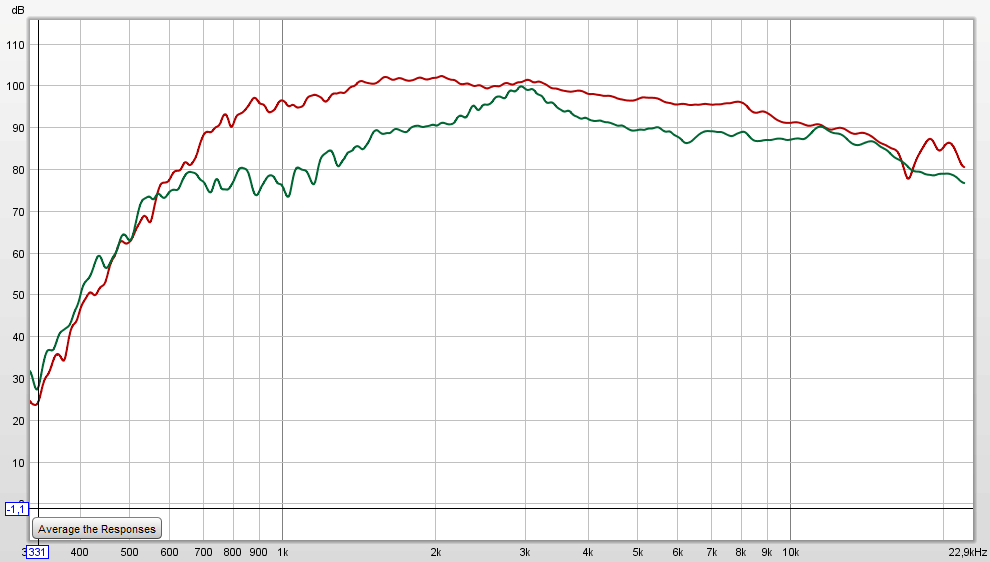
A distortion plot would be fun to see as well.
Here are the plots, black line THD, red 2nd order, yellow 3rd order. First one is the horn, second without.
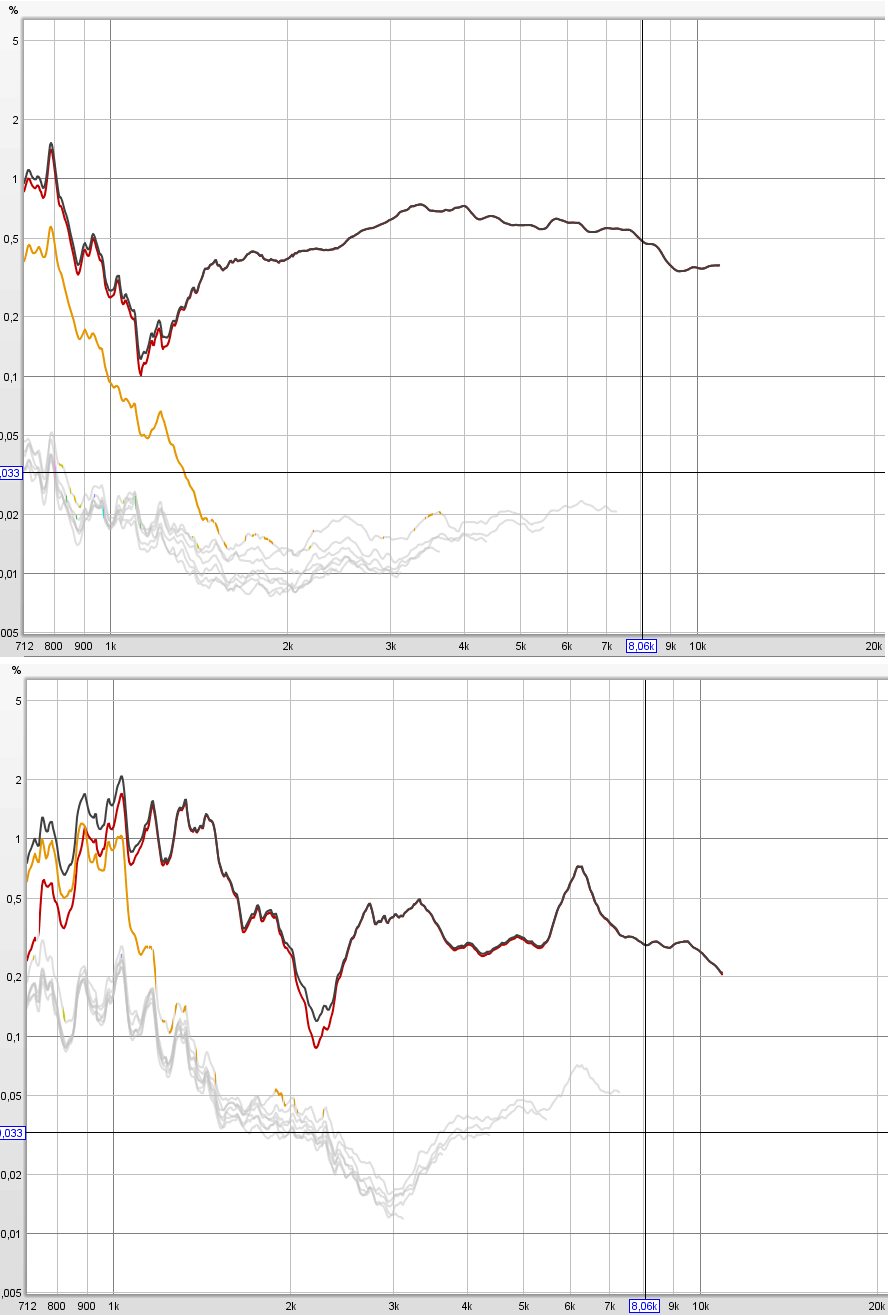
To get really comparable results on the distortion in real life situation, I would have needed to match the volume first on all frequencies, since bare driver needs more power for the same spl. However I think I did it in the past and I recall the results were quite even.
Last edited:
- Status
- This old topic is closed. If you want to reopen this topic, contact a moderator using the "Report Post" button.
- Home
- Loudspeakers
- Multi-Way
- 18sound NSD1095N v's B&C DE250